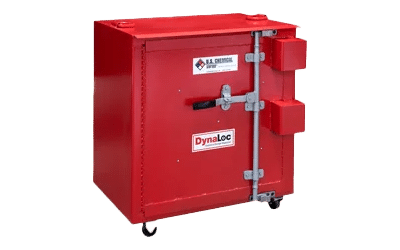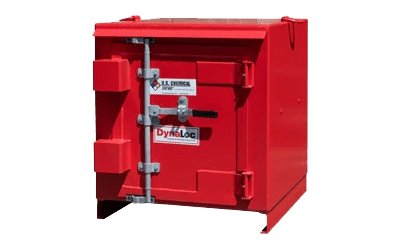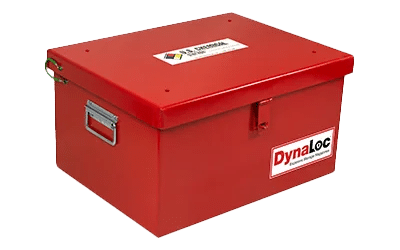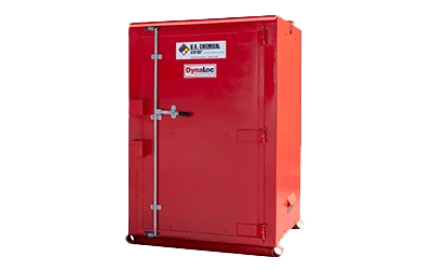DynaLoc® Magazines for Storage of Explosives
When dealing with explosives, safety is essential to a successful outcome. Whether you’re working with high explosives such as dynamite or blasting caps, or low explosives like black powder or display fireworks, every explosive presents a danger. At U.S. Chemical Storage, we understand improper storage methods pose major threats to your safety.

We supply quality engineered Type 2, Type 3, and Type 4 magazines for the storage and transportation of both high and low explosives and ammunition.
Types of DynaLoc® Explosive Storage Magazines
Click To Explore!
DynaLoc® Type 2 Indoor Magazine
For storing high explosives (up to 50 lbs.) inside your facility. Front-open (cabinet) and top-open styles available. The portable steel construction-lined hardwood storage magazines keeps your explosive components or ammunition secure and safe. View Product >DynaLoc® Type 2 Outdoor Magazine
For portable outdoor storage of your high explosives. Many models include forklift pockets for easy relocating. Our engineers durable Type 2 portable outdoor storage for your high explosives. View Product >DynaLoc® Type 3 Daybox for Explosives
Use Type 3 storage magazines, also known as “day boxes,” for the transport and temporary, supervised storage of explosives. Adhere to ATF and DOT regulations View Product >DynaLoc® Type 4 for Low Explosives
For indoor or outdoor, long-term storage of low explosives. All include forklift pockets and crane lifting lugs to easily move or relocate. Protected ventilation and double lock security hasps keep the heavy-duty cam lock handle secure. View Product >Explosive Magazine Storage
To help assure the proper handling and safety procedures when using high and low explosives, the federal government requires the use of magazines for storing all classes of explosive materials. At U.S. Chemical Storage, we supply quality engineered Type 2, Type 3, and Type 4 magazines for the storage and transportation of both high and low explosives and ammunition.
All of our magazines are engineered and manufactured at our Wilkesboro, NC, facility. Same day quotes are available on all standard models. Each magazine is available in a wide range of sizes; all prefabricated magazines are customizable to meet your specifications.
All magazines meet and exceed ATF standards, DOT standards, NFPA guidelines, and more, depending on the model type and necessary function.
Features & Functions
Downloadable Information & Fact Sheets
Frequently Asked Questions
For storage purposes, federal requirements classify explosive materials according to their velocity. There are three classes of explosive materials, per ATF 27 CFR 555.202:
- High Explosives – explosives which detonate by means of a blasting cap (dynamite, emulsions, flash powders, etc.)
- Low explosives – explosives which deflagrate when confined (black powder, safety fuses, ignitor cords, “display fireworks,” etc.)
- Blasting agents – explosives consisting of fuel and oxidizer, intended for blasting and unable to detonated by a No. 8 test blasting cap when unconfined (ammonium nitrate-fuel oil and certain water-gels)
For more information, visit https://www.atf.gov/explosives/explosive-storage-requirements.
Yes. High and low explosives that are placed in outdoor magazines should have a grounding system according to the NFPA 70 standard. Grounding protects your magazine and its contents against lightning strike, and it will need to be properly grounded by a licensed electrician. For more information, please refer to NFPA.
Yes. Like all our safe storage buildings, U.S. Chemical Storage can provide custom explosive storage magazines to fit your needs. For assistance creating a custom solution for your storage needs, contact one of our experts.
It is not necessary to place your explosive storage container on a specific type of foundation. However, a foundation such as concrete can help to provide a truly level surface. Be sure to check your local guidelines to determine if any footer is required.
No. A common misconception is explosive storage magazines will contain a blast inside the unit—this is not the case. Explosive storage magazines work as a safeguard against theft and accidental detonation by improper storage and the environment.
Day boxes are used for the transfer and temporary, supervised storage of your explosives. These magazines are light enough for daily transport from your overnight storage area to the job site. Our DynaLoc™ day boxes are constructed to be fire-resistant, weather-resistant, and theft-resistant
Each class requires a unique storage solution to ensure optimal safety and management. Type 2 is for storage of high explosives, Type 4 is for storage of low explosives, and Type 3 are day boxes that are used to transport both high and low explosives.
Our Type 2 and Type 4 explosive storage magazines are available in both indoor and outdoor styles, and every storage type we offer features theft-resistant, weather-resistant, and fire-resistant construction.
No. A common misconception is explosive storage magazines will contain a blast inside the unit—this is not the case. Explosive storage magazines work as a safeguard against theft and accidental detonation by improper storage and the environment.
Blasting caps, detonating primers, and primed cartridges should not be stored in the same magazine as other explosives. That is why cap boxes are vital. They are portable like a type 3 daybox, (2 man lift) and do not have wheels. Our DynaLoc™ cap boxes are constructed to be fire-resistant, weather-resistant, and theft-resistant.
Request a Quote

YOUR PARTNER IN THE PROCESS. EXPERIENCE YOU CAN TRUST.
We deliver the precise building solution with the speed, security, and high quality that you demand.




